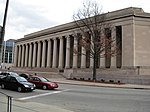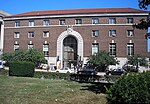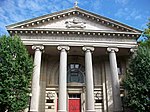Software Engineering Institute
1984 establishments in the United StatesCarnegie Mellon UniversityComputer science institutes in the United StatesCyberwarfareFederally Funded Research and Development Centers ... and 4 more
Organizations based in PittsburghOrganizations established in 1984Software engineering organizationsUse mdy dates from December 2018

The Software Engineering Institute (SEI) is an American research and development center headquartered in Pittsburgh, Pennsylvania. Its activities cover cybersecurity, software assurance, software engineering and acquisition, and component capabilities critical to the United States Department of Defense.
Excerpt from the Wikipedia article Software Engineering Institute (License: CC BY-SA 3.0, Authors, Images).Software Engineering Institute
Henry Street, Pittsburgh
Geographical coordinates (GPS) Address External links Nearby Places Show on map
Geographical coordinates (GPS)
| Latitude | Longitude |
|---|---|
| N 40.4466 ° | E -79.95 ° |
Address
Software Engineering Institute
Henry Street
15213 Pittsburgh
Pennsylvania, United States
Open on Google Maps







